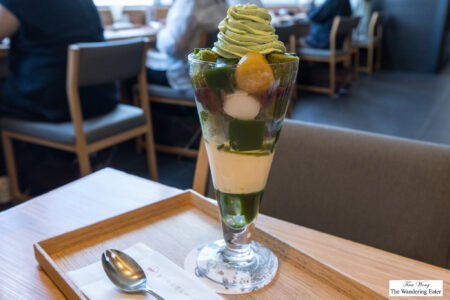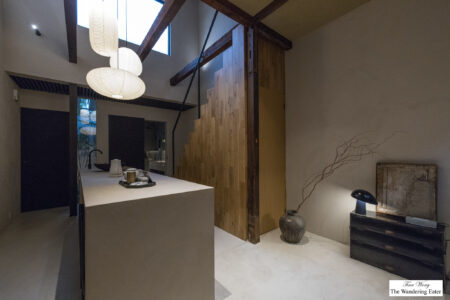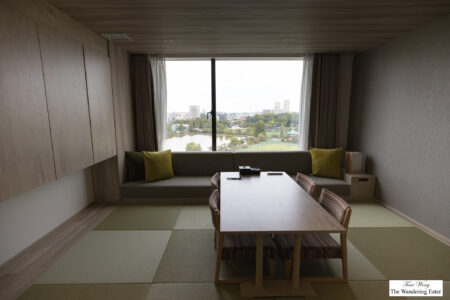
Mis en place for Chefs Ken Oringer & Jamie Bissonette’s class
This year’s 7th Annual New York Culinary Experience took place this weekend on April 11 and 12th. It was co-hosted by Gillian Duffy, culinary editor of New York magazine and Dorothy Cann Hamilton, founder and CEO of International Culinary Center (ICC).
The New York Culinary Experience is the only culinary event that gives food enthusiasts and aspiring cooks the chance to enjoy an intimate weekend of hands-on master cooking classes and conversation with more than 30 of the most prominent chefs in the world.


Seared scallops dish by Chef Markus Glocker; Roasted Chicken Thighs with Mimolette & Asparagus by Chef Justin Smillie
Some of this year’s chefs and culinary experts include: Einat Admony of Balaboosta, Bar Bolonat, Taim; Colman Andrews of The Daily Meal; Emma Bengtsson of Aquavit; David Bouley of Bouley and Brushstroke; Cesare Casella of Salumeria Rosi and a dean at ICC; Zachary Golper of Bien Cuit; Markus Glocker of Batard; Roger Gural of Arcade Bakery; Kurt Gutenbrunner of Wallse; Shaun Hergatt of Juni; David Lebovitz, author of My Paris Kitchen; Ken Oringer & Jamie Bissonnette of Toro; Francois Payard of FP Patisserie, Justin Smillie of Upland; Jacques Torres of Jacques Torres Chocolate and longtime dean of ICC; Bruno Verjus of Table (Paris, France); and many others.


Part of Breakfast; Latte from La Colombe
Every morning we have a light breakfast of pastries and fresh fruit. The life saver for us waking up so early is the just pulled shots of espresso (and its variation of drinks like latte and cortado) from La Colombe.


Chef Ken Oringer adding Kettle brand potato chips to the tortilla Española; Cooking our own tortilla Española (with Oringer adding pea shoots to our batch)
One of my classes was with Chefs Ken Oringer and Jamie Bissonette of Toro (in Boston and New York) about basic Spanish tapas. They are a funny and engaging duo that knows their basics of tapas but add their American sensibilities to the recipes.
The most unexpected thing for me to throw into a tortilla Española is potato chips. (A tortilla Española is akin to a frittata but done on the stovetop and it tastes better when left aside to cool to room temperature.) The chips added a crunchy texture that I normally don’t associate in a tortilla but it makes it so much more interesting. Yes, potato chips are not orthodox (as well as the pea shoots Chef Oringer added to our pan) but breaking some rules to tradition is actually fine.
Oringer and Bissonette’s paella was a stunner. We got our hands into cooking our own smaller pans of paella and it tasted pretty darn phenomenal.
I never cooked Moroccan food but absolutely am astounded by the depth and complexity of flavors of that cuisine hence my taking Chef Einat Admony’s class. (I am partial to her incredible Mediterranean/Israeli food at her restaurants, even back in my college days (if you searched for it) and have the earth changing falafel and sabichs at Taïm.)
This petite, powerhouse of a woman and chef had made fresh couscous from scratch with farina, olive oil and water and manage to teach us how to make a chicken tagine, preserved lemons, delicious pickled carrots, and a spicy tomato condiment/sauce called matbucha.
When you get to taste the completed dish (as seen above, plated by Chef Admony), one cannot but help to have their mind blown how amazing all of this tasted, especially the freshly made couscous. As humble as the couscous might be, it made a world of a difference to eat fresh couscous from the packaged stuff.


Chef Emma Bengtsson of Aquavit & her Scandavian boulliabase
Chef Emma Bengtsson of the recently minted 2* Michelin restaurant, Aquavit kept it short and sweet for us by teaching us her modern take on the Scandinavian bouillabaisse. Exquisite seafood flavors but keeping in mind of the Scandinavian flavors with pickled vegetables. The parsley aioli added a beautiful pastel green color to the dish, as well as a fresh herbaceousness with a touch of creamy salinity.
The one I was the most interested in learning from is Chef Bruno Verjus of Table restaurant in Paris, France. I don’t know much about Verjus’ food prior to this class. (All I knew is his professions as a food writer and radio host besides a chef.)
What I really understood from his style of food is to keep it simple and as wholesome as possible. It’s pretty low maintenance cooking, so to speak, and the ingredients that make up the dish speaks for themselves. For example, his root vegetable salad is essentially beautiful, colorful root vegetables sliced on a mandolin but the infused star anise seed oil and the trout and salmon roes were the important parts to make this salad interesting. Gentle anise flavors with salty, briny flavors of the roes mingling with the sweet, crunchy vegetables.
The seared monkfish dish also surprised me about its relative minimalist cooking. Have the (ugly) monkfish skinned and filleted in two large sections, and sit in a brine of salty as the sea water for 10 minutes or so. Sear the monkfish in olive oil (and do not season the fish at all) until all sides are golden brown and set it aside with a lid on to continue cooking, and continue cooking the other parts of the dish. The monkfish managed to be very flavorful and did not require another sprinkling of salt when we ate the fish. The bay leaf oil and leek top ash were the flavor tweakers to the dish.
If I have anything to take away from Verjus’ class, start infusing spice and/or herb oils and add them to my food; it adds an unexpected flavor profile.
To view more photos of this visit, please view the slideshow below (or CLICK HERE):
[alpine-phototile-for-flickr src=”set” uid=”26389565@N00″ sid=”72157651518156668″ imgl=”flickr” style=”gallery” row=”4″ grwidth=”1200″ grheight=”800″ size=”640″ num=”20″ shadow=”1″ align=”center” max=”100″]
Information:
New York Culinary Experience
Website: http://nyce.nymag.com
at
International Culinary Center
462 Broadway (at Grand)
New York, NY 10013
The cost for the weekend is $1,695 per ticket and includes all classes, breakfast, lunch, and a wine reception each day ($2,070 including the April 11 dinner).











